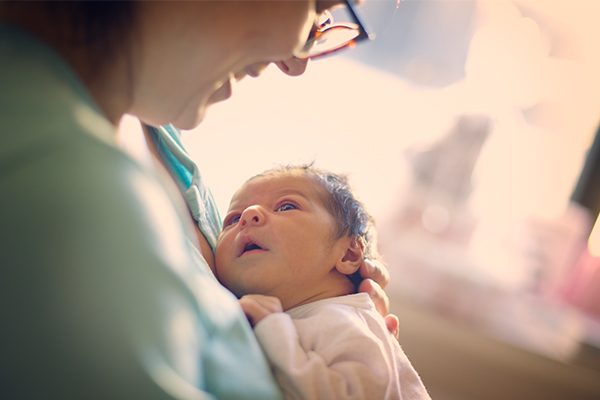October is Breast Cancer Awareness Month. One in eight women will develop breast cancer in their lifetime. This is a pretty scary statistic! We know that early detection of breast cancer is the best way to save lives, and the most important tool for early detection is the mammogram.
Women often ask me when they should have a mammogram. It can be confusing, since there are conflicting guidelines for breast cancer screening. I will briefly review those guidelines and then help you decide what is best for you.
Breast cancer screening guidelines in the United States have been issued primarily by the American Cancer Society (ACS) and the United States Preventive Services Task Force (USPSTF). The American Cancer Society recommends yearly mammograms, beginning at age 40 and continuing as long as a woman is in good health. The USPSTF, which examines the available scientific evidence and makes recommendations on the basis of the data, recommends mammograms every 2 years from ages 50 to 74; the decision to check mammograms before age 50, according to the USPSTF, should be individualized and take into account the woman's values regarding risks and benefits of mammograms.
Given these conflicting recommendations, how is a woman to know what to do?
Before I give you my advice, I want to make two important points.
First, as with anything in healthcare, guidelines can be very helpful; BUT, the decision must be personal. There must be a conversation between you and your healthcare provider that takes into account who you are and what your situation is. Everyone is different, and guidelines must be applied to individuals.
Second, although it is good that the USPSTF guidelines are evidence-based, the evidence is not always complete. We do not have scientific studies to answer every heatlhcare question, and the studies we do have are not always perfect.
In my practice, I follow the ACS guidelines. I recommend annual mammograms, starting at age 40. On rare occasion, based on risk factors, I recommend screening earlier than age 40. Physicians used to routinely recommend a so-called "baseline mammogram" at age 35, but this is no longer the case. After age 75, I discuss the option of a mammogram with women in the context of their overall health. That is, if a woman is healthy, vigorous, and would want breast cancer treatment (and be healthy enough to undergo it) should cancer be discovered on mammogram after age 75, then I recommend one; if not, I don't.
A word about risk: the mammogram, in and of itself, is a very safe test. We always worry about radiation exposure when undergoing x-rays, CT scans, and similar tests; but the radiation involved with a mammogram is extremely low. In fact, the radiation exposure with a mammogram is a fraction of that involved with an upper GI series or spine X-rays. A lifetime of mammograms entails little more radiation exposure than a single CT scan of the abdomen and pelvis. As you can see, the risk of mammogram is not in the radiation (i.e., mammograms do not cause breast cancer!). While uncommon, a mammogram can result in a "0 positive" meaning that the mammogram is abnormal, but you do not have breast cancer. This may lead to unnecessary worries and breast biopsies.
The breast MRI option
You have probably heard about breast MRI and may have questions about that as well, so let's address it briefly. Although breast MRI is not new, it is still an emerging technology and its role is still being determined. As such, it is not always covered by insurance, which (since it is a very expensive test) affects its utilization in screening. For screening purposes, the MRI is typically only recommended for women who have a predicted lifetime breast cancer risk of more than 20%. How do you calculate breast cancer risk? There are different ways, but I typically use the tool found here, from the National Cancer Institute. The advantage of the breast MRI is that it is much more sensitive than mammogram, which means it is more likely to pick up an abnormality. Unfortunately, the trade-off is that it also has a higher "0 positive" rate, meaning that not every abnormality it finds will turn out to be a cancer. This, too, can lead to unnecessary biopsies. When MRI is used for screening, it is recommended in addition to, not instead of, a mammogram. As yet, we have no evidence for improvement in breast cancer survival with MRI as compared to mammogram alone for screening, even in high risk women.
Where to go for a mammogram
I hope this information helps you know whether you should have a mammogram. If you do need a mammogram and do not know where to go, consider the following: in northeast Indiana, check out the Parkview Health website for mammogram locations. In northwest Ohio, digital mammography is available at Parkview Physicians Group - Midwest Community Health Associates and at Fulton County Health Center. If you cannot afford a mammogram, please check out Francine's Friends Mobile Mammography program or the Fulton County Health Department (in Ohio) to see if you qualify for a free mammogram. Finally, for your own personalized Early Detection Plan (including a mobile app!), I encourage you to check out the National Breast Cancer Foundation website.
Please feel free to share your thoughts below. What's keeping you from getting your mammogram? What would you tell others who are hesitant to have a mammogram? Have you had a particularly good mammogram experience? If so, where, and what made it so good?



